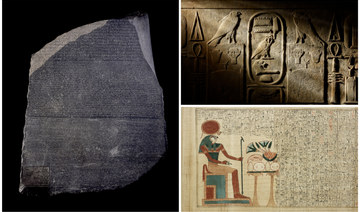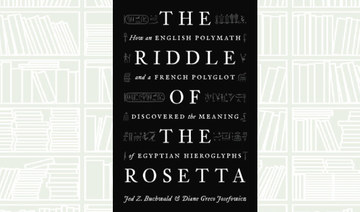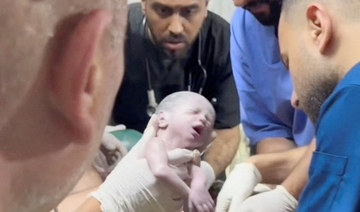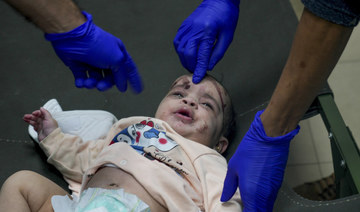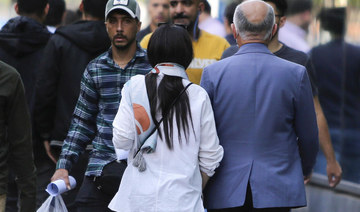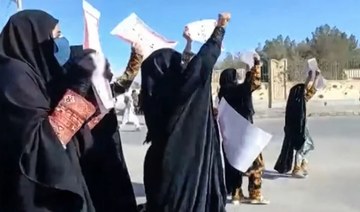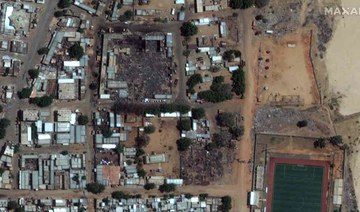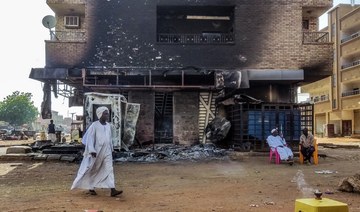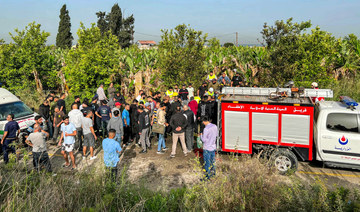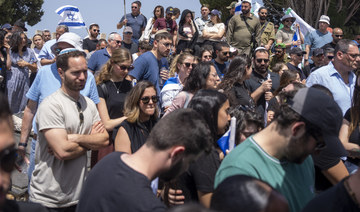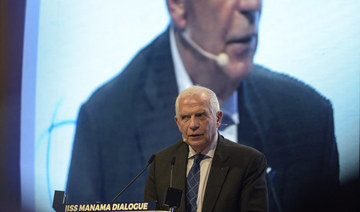CAIRO: The debate over who owns ancient artifacts has been an increasing challenge to museums across Europe and America, and the spotlight has fallen on the most visited piece in the British Museum: The Rosetta Stone.
The inscriptions on the black granite slab became the seminal breakthrough in deciphering ancient Egyptian hieroglyphics after it was taken from Egypt by forces of the British empire in 1801.
Now, as Britain’s largest museum marks the 200-year anniversary of the decipherment of hieroglyphics, thousands of Egyptians are demanding the stone’s return.
‘’The British Museum’s holding of the stone is a symbol of Western cultural violence against Egypt,” said Monica Hanna, dean at the Arab Academy for Science, Technology & Maritime Transport, and organizer of one of two petitions calling for the stone’s return.
The acquisition of the Rosetta Stone was tied up in the imperial battles between Britain and France. After Napoleon Bonaparte’s military occupation of Egypt, French scientists uncovered the stone in 1799 in the northern town of Rashid, known by the French as Rosetta. When British forces defeated the French in Egypt, the stone and over a dozen other antiquities were handed over to the British under the terms of an 1801 surrender deal between the generals of the two sides.
It has remained in the British Museum since.
Hanna’s petition, with 4,200 signatures, says the stone was seized illegally and constitutes a “spoil of war.” The claim is echoed in a near identical petition by Zahi Hawass, Egypt’s former minister for antiquities affairs, which has more than 100,000 signatures. Hawass argues that Egypt had no say in the 1801 agreement.
The British Museum refutes this. In a statement, the Museum said the 1801 treaty includes the signature of a representative of Egypt. It refers to an Ottoman admiral who fought alongside the British against the French. The Ottoman sultan in Istanbul was nominally the ruler of Egypt at the time of Napoleon’s invasion.
The Museum also said Egypt’s government has not submitted a request for its return. It added that there are 28 known copies of the same engraved decree and 21 of them remain in Egypt.
The contention over the original stone copy stems from its unrivaled significance to Egyptology. Carved in the 2nd century B.C., the slab contains three translations of a decree relating to a settlement between the then-ruling Ptolemies and a sect of Egyptian priests. The first inscription is in classic hieroglyphics, the next is in a simplified hieroglyphic script known as Demotic, and the third is in Ancient Greek.
Through knowledge of the latter, academics were able to decipher the hieroglyphic symbols, with French Egyptologist Jean-Francois Champollion eventually cracking the language in 1822.
‘‘Scholars from the previous 18th century had been longing to find a bilingual text written in a known language,’’ said Ilona Regulski, the head of Egyptian Written Culture at the British Museum. Regulski is the lead curator of the museum’s winter exhibition, “Hieroglyphs Unlocking Ancient Egypt,” celebrating the 200th anniversary of Champollion’s breakthrough.
The stone is one of more than 100,000 Egyptian and Sudanese relics housed in the British Museum. A large percentage were obtained during Britain’s colonial rule over the region from 1883 to 1953.
It has grown increasingly common for museums and collectors to return artifacts to their country of origin, with new instances reported nearly monthly. Often, it’s the result of a court ruling, while some cases are voluntary, symbolizing an act of atonement for historical wrongs.
New York’s Metropolitan Museum returned 16 antiquities to Egypt in September after a US investigation concluded they had been illegally trafficked. On Monday, London’s Horniman Museum signed over 72 objects, including 12 Benin Bronzes, to Nigeria following a request from its government.
Nicholas Donnell, a Boston-based attorney specializing in cases concerning art and artifacts, said no common international legal framework exists for such disputes. Unless there is clear evidence an artifact was acquired illegally, repatriation is largely at the discretion of the museum.
‘‘Given the treaty and the timeframe, the Rosetta Stone is a hard legal battle to win,’’ said Donnell.
The British Museum has acknowledged that several repatriation requests have been made to it from various countries for artifacts, but it did not provide The Associated Press with any details on their status or number. It also did not confirm whether it has ever repatriated an artifact from its collection.
For Nigel Hetherington, an archaeologist and CEO of the online academic forum Past Preserves, the museum’s lack of transparency suggests other motives.
‘‘It’s about money, maintaining relevance and a fear that in returning certain items people will stop coming,’’ he said.
Western museums have long pointed to superior facilities and larger crowd draws to justify their holding of world treasures. Amid turmoil following the 2011 uprising that toppled autocrat Hosni Mubarak, Egypt saw an uptick in artifact smuggling, which cost the country an estimated $3 billion between 2011 and 2013, according to the US-based Antiquities Coalition. In 2015, it was discovered that cleaners at Cairo’s Egyptian Museum had damaged the burial mask of Pharaoh Tutankhamun by attempting to re-attach the beard with super glue.
But President Abdel Fattah El-Sisi’s government has since invested heavily in its antiquities. Egypt has successfully reclaimed thousands of internationally smuggled artifacts and plans to open a newly built, state-of-the-art museum where tens of thousands of objects can be housed. The Grand Egyptian Museum has been under construction for well over a decade and there have been repeated delays to its opening.
Egypt’s plethora of ancient monuments, from the pyramids of Giza to the towering statues of Abu Simbel at the Sudanese border, are the magnet for a tourism industry that drew in $13 billion in 2021.
For Hanna, Egyptians’ right to access their own history should remain the priority. “How many Egyptians can travel to London or New York?” she said.
Egyptian authorities did not respond to a request for comment regarding Egypt’s policy toward the Rosetta Stone or other Egyptian artifacts displayed abroad. Hawass and Hanna said they are not pinning hopes on the government to secure its return.
‘‘The Rosetta Stone is the icon of Egyptian identity,’’ said Hawass. ‘‘I will use the media and the intellectuals to tell the (British) museum they have no right.’’
Egyptians call on British Museum to return Rosetta Stone
https://arab.news/8h87h
Egyptians call on British Museum to return Rosetta Stone

Gaza baby rescued from dead mother’s womb dies
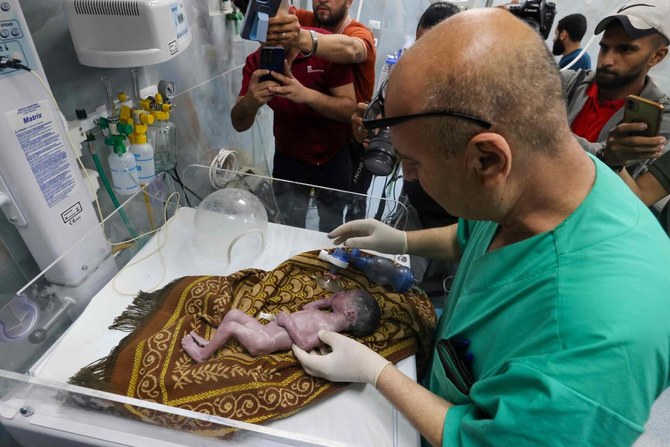
- Doctors were able to save the baby, delivering her by Caesarean section
- The baby suffered respiratory problems and a weak immune system, said Doctor Mohammad Salama who had been caring for Sabreen Al-Rouh
RAFAH, Gaza Strip: A baby girl who was delivered from her dying mother’s womb in a Gaza hospital following an Israeli airstrike has herself died after just a few days of life, the doctor who was caring for her said on Friday.
The baby had been named Sabreen Al-Rouh. The second name means “soul” in Arabic.
Her mother, Sabreen Al-Sakani (al-Sheikh), was seriously injured when the Israeli strike hit the family home in Rafah, the southernmost city in the besieged Gaza Strip, on Saturday night.
Her husband Shukri and their three-year-old daughter Malak were killed.
Sabreen Al-Rouh, who was 30-weeks pregnant, was rushed to the Emirati hospital in Rafah. She died of her wounds, but doctors were able to save the baby, delivering her by Caesarean section.
However, the baby suffered respiratory problems and a weak immune system, said Doctor Mohammad Salama, head of the emergency neo-natal unit at Emirati Hospital, who had been caring for Sabreen Al-Rouh.
She died on Thursday and her tiny body was buried in a sandy graveyard in Rafah.
“I and other doctors tried to save her, but she died. For me personally, it was a very difficult and painful day,” he told Reuters by phone.
“She was born while her respiratory system wasn’t mature, and her immune system was very weak and that is what led to her death. She joined her family as a martyr,” Salama said.
More than 34,000 Palestinians, many of them women and children, have been killed in the six-month-old war in Gaza between Israel and Hamas militants, according to the Gaza health ministry. Israel denies deliberately targeting civilians in its campaign to eradicate Hamas.
Much of Gaza has been laid to waste by Israeli bombardments and most of the enclave’s hospitals have been badly damaged, while those still operating are short of electricity, medicine sterilization equipment and other supplies.
“(Sabreen Al-Rouh’s) grandmother urged me and the doctors to take care of her because she would be someone that would keep the memory of her mother, father and sister alive, but it was God’s will that she died,” Salama said.
Her uncle, Rami Al-Sheikh Jouda, sat by her grave on Friday lamenting the loss of the infant and the others in the family.
He said he had visited the hospital every day to check on Sabreen Al-Rouh’s health. Doctors told him she had a respiratory problem but he did not think it was bad until he got a call from the hospital telling him the baby had died.
“Rouh is gone, my brother, his wife and daughter are gone, his brother-in-law and the house that used to bring us together are gone,” he told Reuters.
“We are left with no memories of my brother, his daughter, or his wife. Everything was gone, even their pictures, their mobile phones, we couldn’t find them,” the uncle said.
UN denounces ‘more serious’ Iran crackdown on women without veils
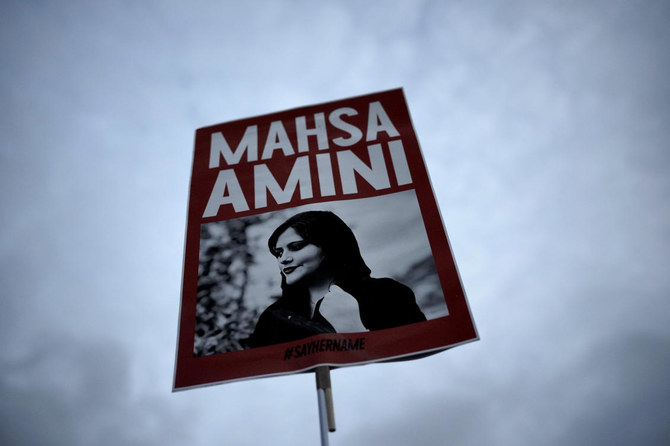
- Hundreds of businesses including restaurants and cafes have been shut down for not enforcing the hijab rule
- More women began refusing the veil in the wake of the 2022 death in custody of 22-year-old Mahsa Amini
GENEVA: The United Nations said Friday that it was concerned by reports of new efforts to track and punish Iranian women, some as young as 15, who refuse to wear the headscarf required under the country’s Islamic law.
The UN Human Rights Office also expressed alarm about a draft bill on “Supporting the Family by Promoting the Culture of Chastity and Hijab,” which would impose tougher sentences on women appearing in public without the hijab.
“What we have seen, what we’re hearing is, in the past months, that the authorities, whether they be plainclothes police or policemen in uniform, are increasingly enforcing the hijab bill,” Jeremy Laurence, a spokesman for the office, said at a press conference.
“There have been reports of widespread arrests and harassment of women and girls — many between the ages of 15 and 17,” he said.
Iranian police announced in mid-April reinforced checks on hijab use, saying the law was increasingly being flouted.
Hundreds of businesses including restaurants and cafes have been shut down for not enforcing the hijab rule, and surveillance cameras are being used to identify women without it, Laurence said.
More women began refusing the veil in the wake of the 2022 death in custody of 22-year-old Mahsa Amini after her arrest by Iran’s morality police for allegedly breaking the headscarf law, which sparked a wave of deadly protests against the government.
Laurence said that on April 21, “the Tehran head of the Islamic Revolutionary Guard Corps announced the creation of a new body to enforce existing mandatory hijab laws, adding that guard members have been trained to do so ‘in a more serious manner’ in public spaces.”
And while the latest draft of the new hijab bill has not been released, “an earlier version stipulates that those found guilty of violating the mandatory dress code could face up to 10 years’ imprisonment, flogging, and fines,” he said, adding that “this bill must be shelved.”
The Human Rights Office also called for the release of a rapper sentenced to death for supporting nationwide protests sparked by Amini’s death.
Toomaj Salehi, 33, was arrested in October 2022 for publicly backing the uprising.
“All individuals imprisoned for exercising their freedom of opinion and expression, including artistic expression, must be released,” Laurence said.
UN seeks to deescalate Sudan tensions amid reports of possible attack
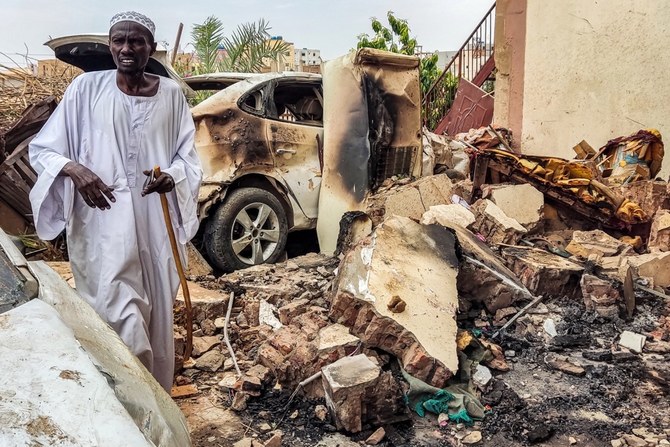
- UN Secretary-General Antonio Guterres’ envoy is engaging with all parties to deescalate tensions
UNITED NATIONS: The United Nations is increasingly concerned about escalating tensions in Al-Fashir in Sudan’s North Dafur region amid reports that the Rapid Support Forces are encircling the city, signaling a possible imminent attack, the UN’s spokesperson said on Friday.
UN Secretary-General Antonio Guterres’ envoy is engaging with all parties to deescalate tensions in the area, the spokesperson said.
Israeli army says missile fire kills civilian near Lebanon
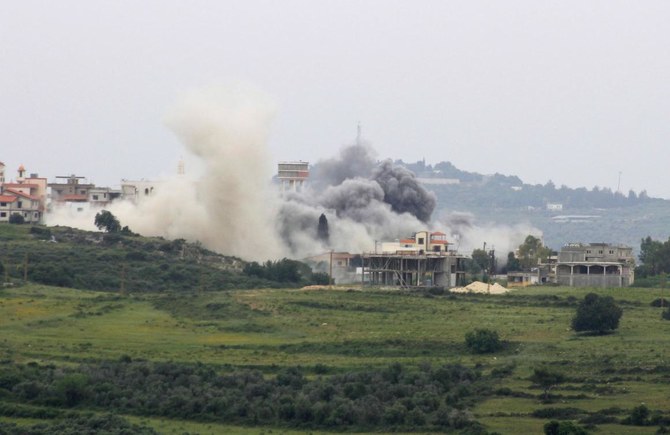
- The violence has fueled fears of all-out conflict between Iran-backed Hezbollah and Israel
- “Overnight, terrorists fired anti-tank missiles toward the area of Har Dov in northern Israel,” the Israeli army said
JERUSALEM: The Israeli army said Friday a civilian was killed near the country’s northern border with Lebanon, as near-daily exchanges of fire with Hezbollah rage.
Both sides have stepped up attacks this week, with Hezbollah increasing rocket fire and Israel saying it had carried out “offensive action” across southern Lebanon.
The violence has fueled fears of all-out conflict between Iran-backed Hezbollah and Israel, which last went to war in 2006.
“Overnight, terrorists fired anti-tank missiles toward the area of Har Dov in northern Israel,” the Israeli army said, referring to the disputed Shebaa Farms district.
“As a result, an Israeli civilian doing infrastructure work was injured and he was later pronounced dead.”
Israeli media reported that the victim was an Arab-Israeli truck driver. Police told AFP they had not identified the body, but said it was the only one found after a truck was hit.
Hezbollah said it had destroyed two Israeli vehicles in the Kfarshuba hills overnight in a “complex ambush” on a convoy using missiles and artillery.
The Israeli army did not comment directly on the claim.
It said Israeli fighter jets struck Hezbollah targets around Shebaa village in southern Lebanon including a weapons store and a launcher, while soldiers “fired to remove a threat in the area.”
It said fighter jets also “struck Hezbollah operational infrastructure in the area of Kfarshuba and a military compound in the area of Ain El Tineh in southern Lebanon.”
Lebanon’s official National News Agency reported that Shebaa village, Kfarshuba and Helta were targeted by “more than 150 Israeli shells,” leaving homes damaged.
Iran-backed Hezbollah has been trading almost-daily fire with the Israeli army since the day after its Palestinian ally Hamas carried out an unprecedented attack on Israel on October 7.
Since October 8 at least 380 people have been killed in Lebanon, including 252 Hezbollah fighters and dozens of civilians, according to an AFP tally.
Israel says 11 soldiers and nine civilians have been killed on its side of the border.
Tens of thousands of people have been displaced on both sides.
EU commits $73 million more for Gaza aid
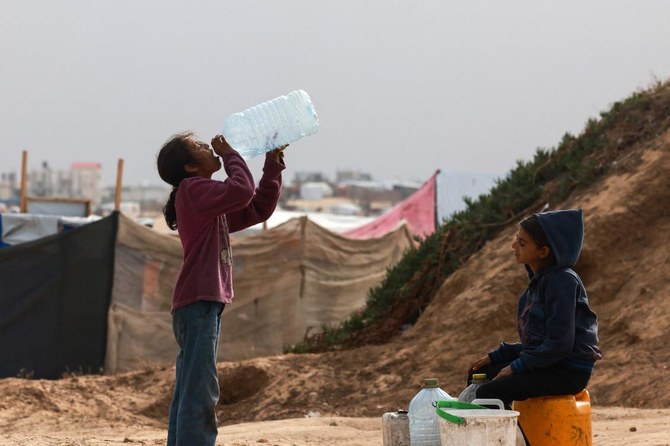
- New EU aid would be focused on food deliveries, clean water, sanitation and shelters
- The EU and United States have demanded that Israel allows more aid into Gaza
BRUSSELS: The European Union on Friday said it was giving an extra 68 million euros ($73 million) to provide desperately needed aid to Palestinians in Gaza.
The territory has been devastated by more than six months of Israeli bombardment and ground operations after Hamas’s October 7 attack, leaving the civilian population of two million people in need of humanitarian assistance to survive.
“In light of the continued deterioration of the severe humanitarian crisis in Gaza, and the steady rise of needs on the ground, the (European) Commission is stepping up its funding to support Palestinians affected by the ongoing war,” an EU statement said.
“This support brings total EU humanitarian assistance to 193 million euros for Palestinians in need inside Gaza and across the region in 2024.”
The EU said the new aid would be focused on food deliveries, clean water, sanitation and shelters, and would be channelled through local partners on the ground.
The United Nations has said Israel’s operation has turned Gaza into a “humanitarian hellscape,” amid fears of a looming famine.
The EU and United States have demanded that Israel allows more aid into Gaza.
The US military said on Thursday it had begun construction of a pier meant to boost deliveries to the territory.
The war in Gaza began with an unprecedented Hamas attack on Israel on October 7 that resulted in the deaths of about 1,170 people in Israel, according to an AFP tally of Israeli official figures.
Israel vowed to destroy Hamas, with a retaliatory offensive that has killed at least 34,356 people in Gaza, mostly women and children, according to the Hamas-run territory’s health ministry.



